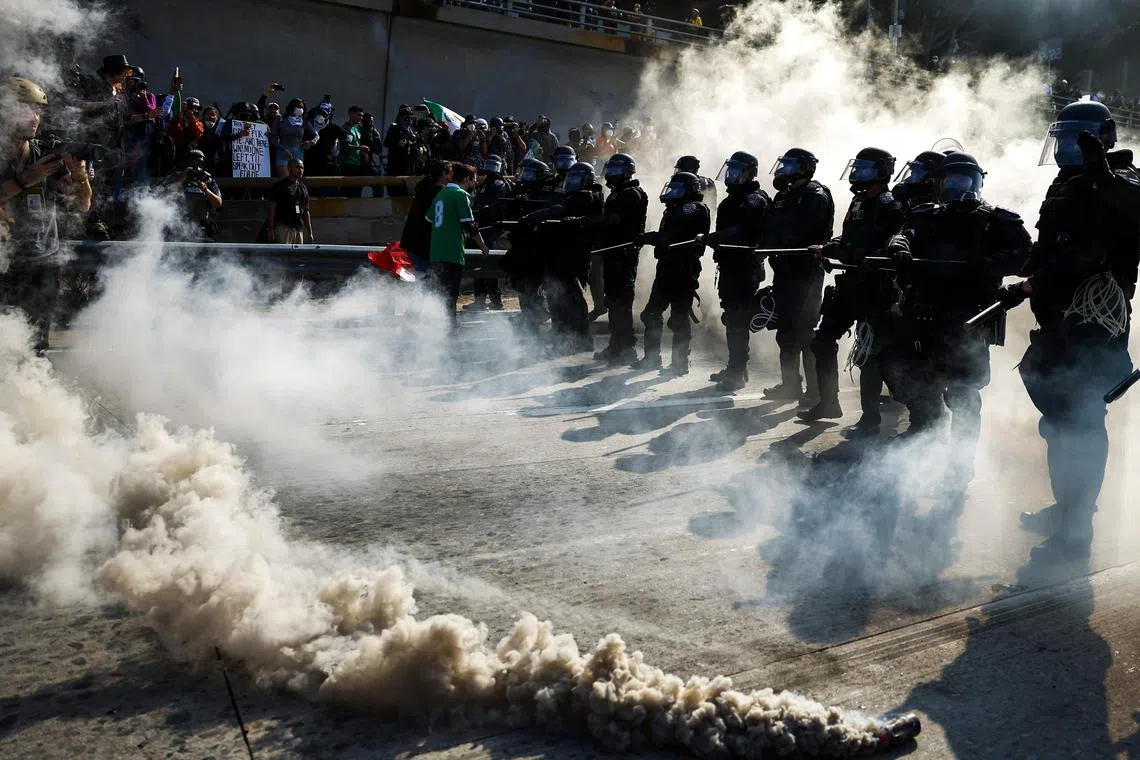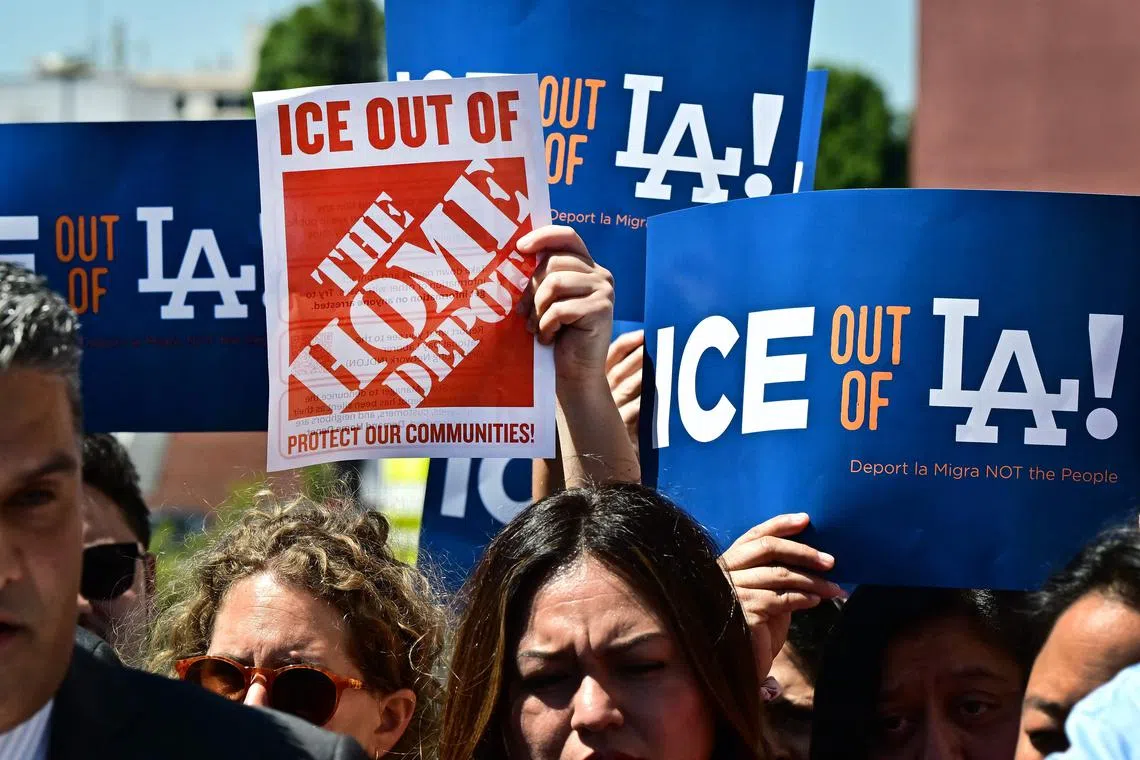‘We all thought the raids were over’: Fears return for immigrants in LA
Sign up now: Get ST's newsletters delivered to your inbox

Police countering activists protesting against immigration raids, near the Edward R. Roybal Federal Building in Los Angeles, California, on June 8.
PHOTO: EPA
Jill Cowan and Ana Facio-Krajcer
Follow topic:
LOS ANGELES – For much of the summer, immigrants in the Los Angeles region lacking legal status had lived in . Many rarely ventured out as masked, heavily armed agents arrested thousands of people as they went about their daily lives.
In recent weeks, however, a sense of normalcy had quietly returned after a judge in Los Angeles temporarily blocked what local officials and activists had described as random, indiscriminate raids.
Most of the National Guard troops and Marines whom President Donald Trump had deployed to the city had been withdrawn, and the President seemed to have shifted his attention to other Democratic-led cities.
Street vendors in Los Angeles returned to sidewalks, workers returned to construction sites, and families hosted birthday parties at local parks.
Now, immigrants, local officials and activists said, the nation’s highest court has ripped away that thin veil of safety. On Sept 8, the Supreme Court overturned the lower court order
“We all thought the raids were over,” said Mr Roberto Cordero, 67, an immigrant lacking legal status who lives in the Los Angeles area. “With this decision, we lost confidence in the courts.”
Hours after the decision on Sept 8, at a park in East Los Angeles, which has one of the largest Mexican American communities in the United States, children still played soccer, and snack vendors pushed carts brimming with bags of chips and chicharrones.
But residents said their community was suddenly facing a fresh round of panic and confusion.
Mr Cordero said he had come to the US from Mexico at the age of 23 and had lived in the region for more than four decades. Since then, he said, he has worked almost non-stop, and currently installs flooring.

Demonstrators at a news conference to discuss a ruling by the Supreme Court that lifted an earlier court injunction limiting federal immigration raids, in Los Angeles on Sept 8.
PHOTO: AFP
The Supreme Court, he said, had given immigration agents “the green light to treat us all the same, like criminals”.
He added: “People are going to be afraid, and they’re going to stop going to work.”
Federal officials declined to discuss their specific plans for the Los Angeles operation after the Supreme Court ruling.
Ms Tricia McLaughlin, a spokeswoman for the Department of Homeland Security, answered questions on Sept 9 by referring to a statement on Sept 8 that celebrated the decision as “a win for the safety of Californians and the rule of law”.
Even after the temporary court order in July, some raids continued, including a high-profile one in which agents poured out of a rented Penske truck outside a Home Depot, in an action named Operation Trojan Horse.
Los Angeles Mayor Karen Bass and other elected officials criticised the administration for violating the court order with that raid and others.
It was not immediately clear how the Supreme Court ruling would change immigration enforcement in Los Angeles. Federal agents have arrested more than 5,000 people since June.
Last week, Mr Gregory Bovino, the Border Patrol chief who has been leading the Los Angeles raids, said in a social media video that his team was “taking this show on the road” and trading “palm trees for some skyscrapers”, an apparent reference to the federal raids in Chicago.
On Sept 9, after the ruling, Mr Bovino posted an image of dozens of Border Patrol officers appearing to stand below the Hollywood sign. All of the agents’ faces were blurred out, except for Mr Bovino’s and that of an agent in a white cowboy hat.
“The mean green team is not going anywhere,” the post said, apparently referring to the colour of their uniforms. “We are here to stay.”
Latino residents said the uncertainty of the raids had hung over their lives this year.
“It affects us all, whether you are here legally or not,” said Mr Jesus Ramirez, 53, who was watching his 10-year-old son’s soccer practice at Ruben Salazar Park in East Los Angeles.
He and his wife, Mrs Micaela Ramirez, 50, were able to get legal status under an amnesty law signed by President Ronald Reagan in 1986.
Mrs Ramirez said she had noticed signs in recent weeks that neighbours were feeling more comfortable about going back out, such as grandmothers resuming school pickups.
“We thought everything was more calm and back to normal,” she said. “Now they’re going to stop going out to pick up the kids out of fear.”
When mass immigration raids escalated in June
Mr Trump sent thousands of California National Guard troops and Marines to Los Angeles, over the objections of Governor Gavin Newsom and local leaders, in response to protests that erupted in downtown Los Angeles and activists who confronted immigration agents.
Unidentified agents targeted Latino people at car washes, Home Depot parking lots and outdoor workplaces. Videos of the encounters shot across social media and through the group chats of landscapers, taqueros and caregivers.
Workers lacking legal status missed their children’s graduations out of fear.
Immigrant rights organisations said the court victories, including the July temporary restraining order, had provided a sliver of hope for legal relief.
But for many, the Supreme Court’s order reinforced what they had been preparing for all summer: a new normal in which immigrants lacking legal status stay underground and Latino residents fear being profiled by federal agents.
Ms Angelica Salas, executive director of the Coalition for Humane Immigrant Rights of Los Angeles, a non-profit organisation known as Chirla, said: “If a people feel like there is no limit to the power, then what they start doing is acquiescing and setting a different mode of operation.
“People are hiding away, and neighbours are helping them survive. That’s not something that we think is normal.”
Ms Salas likened the situation to the way people lived in attics in Nazi Germany.
Some workers lacking legal status have returned to their jobs, she said, but only after they have developed emergency plans for their families in case they are detained.
Many have stayed at home, relying on volunteers for deliveries and falling into deep depression. School car pools have been carefully structured so that only parents or relatives with legal immigration status drop off students.
Ms Kelly Gonez, a Los Angeles Unified School District board member who represents a heavily Latino section of the San Fernando Valley, said that while attendance had generally been strong this school year, there had been a large drop in enrolment in some areas that she said was most likely “connected to the persistent fear in our communities”.
Ms Maegan Ortiz, executive director of Idepsca, a non-profit organisation that operates day labour centres across Los Angeles, said many day labourers are legal residents and that they are afraid of being thrown to the ground or detained without the ability to contact loved ones.
She said local leaders needed to do more than denounce the Supreme Court decision. She wants to see a more confrontational approach, such as using city vehicles to block off Home Depot parking lots, or having local police officers respond to raids and protect residents from agents whose identities are concealed.
After the Supreme Court ruling, she wondered: “Are more people going to get hurt?”
A possible test run for the local government’s response could come this weekend as residents prepare to celebrate Mexican Independence Day at parades and other events.
Mr Hugo Soto-Martinez, a Los Angeles City Council member whose parents immigrated from Mexico, said: “Obviously, I have some concern about people gathering and that being a target.
“I also don’t think we should be cowering in this moment.” NYTimes

